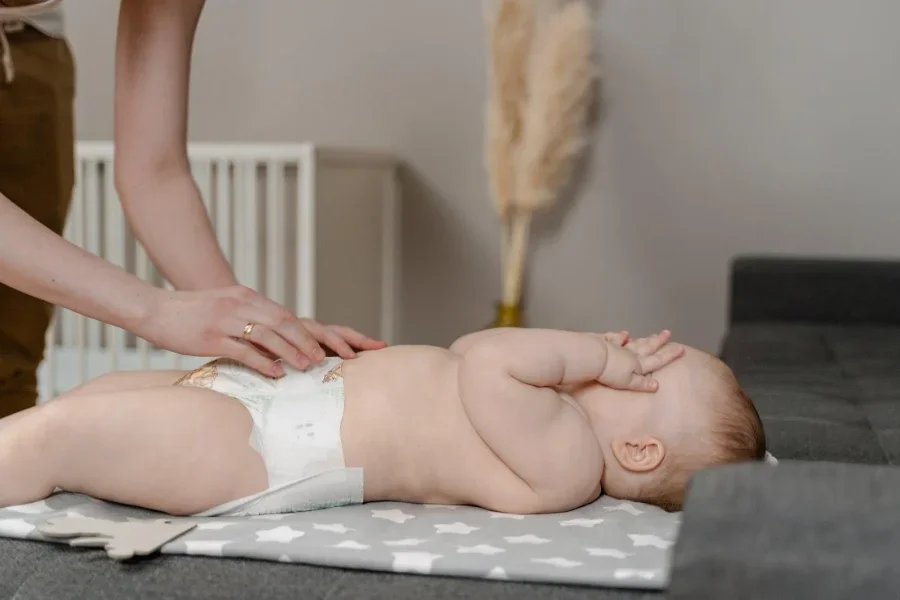Disposable diapers are a must-have for parents with babies, and the market for them is constantly evolving. As a result, brands need to understand and incorporate the latest trends that will increase their revenue and keep their customers satisfied.
With that said, here are five disposable diaper trends that will make a wave in the market and help brands maximize their profits.
Table of Contents
How big is the disposable diaper market?
5 disposable diaper trends to glean in 2023
6 considerations before buying disposable diapers in 2023
Rounding up
How big is the disposable diaper market?
Market size
Statistics report that the global diapers market will grow at a CAGR of 4.9%, going from USD 82.59 billion in 2022 to USD 121.15 billion by 2030. The growing awareness of child health and the shift in consumer options towards eco-friendly products are two major drivers of the global baby diapers market. As a result, more focus is placed on developing bio-ingredients for manufacturing baby diapers, which is also expected to fuel market growth in subsequent years.
Unlike many industries, there was a hike in demand for baby diapers and essential care products during the COVID-19 pandemic. Most parents stocked these products from supermarkets and grocery stores in preparation for the lockdown.
In addition, the U.S. Senate passed an “End Diaper Need Act” in 2021, helping low-income families who cannot afford baby healthcare essentials. This act will enable over USD 200 million in social services every year between 2022 and 2025 for purchasing baby diapers and related supplies for these households.
According to type, synthetic disposable diapers have dominated since 2022, accounting for more than 72.30% of the overall revenue. However, organic diapers are gaining traction and are expected to record the highest CAGR over the forecast period. This anticipation is propelled by the organic product manufacturers’ increased social media marketing and the growing purchase of eco-friendly products (irrespective of price), which are predicted to enhance segment expansion during the analysis period.
Distribution channels
In 2022, the offline segment dominated the distribution channel, making over 76.40% of the total income. Major manufacturers concentrate on retail outlets as their preferred distribution channel to increase product reach, causing retailers to include these products in their product lines. Moreso, the immediate availability and physical verification of diaper products in the offline distribution sector give them an edge over their online counterpart. Notwithstanding, the online segment is expected to grow from 2023 to 2030 as the ease of online shopping continues to gain popularity between sellers and shoppers alike.
Regions
The Asia Pacific region remains the largest consumer of baby diapers, anticipating a rapid growth rate of 5.4% during the forecast period. Furthermore, the endorsement of baby diapers in countries such as India, Indonesia, and Thailand is expected to escalate in subsequent years due to an emerging group of affluent parents. The North American market is also envisaged to grow during the forecast period due to increasing disposable income and demand for organic products in this region.
5 disposable diaper trends to glean in 2023
Breathable disposable diapers
These diapers are created with airflow in mind and thus feature a unique design that allows air to flow through. Interestingly, this diaper type reduces the risk of diaper rash and other skin irritations. The materials used in these diapers also help to regulate babies’ temperature and moisture levels, keeping them comfortable and dry.
Additionally, breathable diapers are usually made from eco-friendly materials, making them an excellent choice for parents looking for sustainable options to keep their babies comfortable and healthy.
Biodegradable disposable diapers

Biodegradable disposable diapers are designed to break down and decompose naturally over time without harming the environment. These diapers are made from plant-based materials, such as bamboo or corn, so they are more sustainable and eco-friendly than synthetic diaper materials.
Moreover, they do not contain any harmful chemicals that some synthetic materials do, making them a safer choice for babies. Parents can reduce their carbon footprint and contribute to a more sustainable future by choosing biodegradable diapers.
Cotton disposable diapers

True to their name, these diapers are made primarily from cotton, a natural and breathable material. In addition, disposable cotton diapers are hypoallergenic and free of chemicals & synthetic additives.
They also provide excellent absorbency, making these diapers comfortable and safe for babies. Furthermore, cotton is a renewable and sustainable resource, making it an eco-friendly option for parents concerned about the environment.
Ultra-thin adult disposable diapers
This special type of adult diaper is less bulky and more discreet than conventional designs but still provides the necessary protection against leaks. Like traditional diapers, they are made with highly absorbent materials allowing them to hold a significant amount of liquid, despite their thin profile.
Caregivers looking for an easy-to-use, discreet, and reliable solution for their aged loved ones will find these diapers highly beneficial to managing incontinence. Other consumers of this product are active adults who want to maintain their active lifestyle without worrying about embarrassing leaks or discomfort.
Lightweight disposable diapers

Lightweight disposable diapers are typically made with feather-weight materials that can still provide excellent absorbency and leak protection. They are ideal for active adults who don’t want to be weighed down by a bulky diaper and for parents who want a portable diaper convenient for changing on the go.
They are also an excellent option for sensitive skin or allergies, as they are less likely to cause irritation or discomfort.
6 considerations before buying disposable diapers in 2023
Diaper material
Diaper material differs from vendor to vendor, even though they may all look the same. Each material used has its pros over an alternative material.
For example, diapers made from natural materials such as cotton, bamboo, or hemp may be more comfortable for babies and toddlers with sensitive skin or allergies. These materials are also biodegradable, making them a more eco-friendly choice.
On the other hand, synthetic materials like polypropylene, polyester, and SAP (super-absorbent polymers) are designed to be highly absorbent and to wick moisture away from the skin.
It is vital to note that different materials used can affect a diaper’s comfort, breathability, absorbency, and durability.
Fit and stretchability
When purchasing diapers, Choosing one with an adjustable fit for different body shapes is essential. A diaper that is too loose can result in leaks, while a diaper that is too tight can cause discomfort and irritation for the baby.
Wearer’s size
Diapers come in different sizes, from newborn to larger sizes for toddlers and older children, and it’s essential to choose the right size to ensure a comfortable and secure fit. Brands should consider their target’s size before making any offers or provide various sizes to help guide buyers’ decisions.
Biodegradability
Biodegradability is becoming an increasingly important factor for environmentally conscious consumers when choosing disposable diapers. In addition, consumers concerned about reducing their environmental impact may choose biodegradable diapers over traditional disposable diapers.
However, it is essential to note that not all biodegradable diapers are created equal. Some may take a long time or require specific disposal methods to decompose.
Wetness indicator
A wetness indicator is a color-changing strip outside the diaper that signals when the diaper is wet and needs changing. It’s a helpful feature for new parents getting used to their baby’s diapering routine or those who want to minimize unnecessary diaper changes. Wetness indicators can also help prevent diaper rash by ensuring timely diaper changes.
Not all disposable diapers come with wetness indicators, and some parents prefer relying on their judgment or their baby’s cues to determine when a diaper needs changing.
Absorbency
Absorbency is a critical factor when it comes to choosing disposable diapers. The primary function of disposable diapers is to absorb and hold wetness, keeping the baby comfortable and dry.
The absorbency of a diaper is determined by its design, materials used, and the number of layers. Some disposable diapers have higher absorbency levels than others, making them ideal for overnight use, while others are better suited for daytime use.
Rounding up
The disposable diapers market is growing with the current natality rates, keeping the demand for these products high and fresh. By understanding and implementing these five trends, brands can keep their customers happy and engaged while gaining profit and promoting their brand name.
Whether offering sustainable and eco-friendly options or providing personalized high-tech features, businesses can boost sales and establish themselves as leaders in the disposable diaper market.




 Afrikaans
Afrikaans አማርኛ
አማርኛ العربية
العربية বাংলা
বাংলা Nederlands
Nederlands English
English Français
Français Deutsch
Deutsch हिन्दी
हिन्दी Bahasa Indonesia
Bahasa Indonesia Italiano
Italiano 日本語
日本語 한국어
한국어 Bahasa Melayu
Bahasa Melayu മലയാളം
മലയാളം پښتو
پښتو فارسی
فارسی Polski
Polski Português
Português Русский
Русский Español
Español Kiswahili
Kiswahili ไทย
ไทย Türkçe
Türkçe اردو
اردو Tiếng Việt
Tiếng Việt isiXhosa
isiXhosa Zulu
Zulu